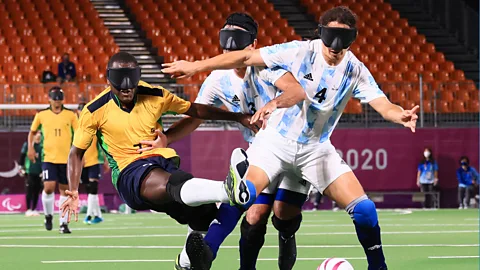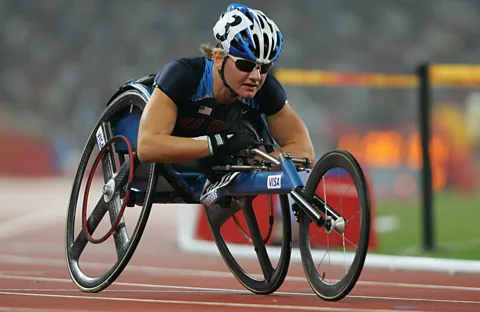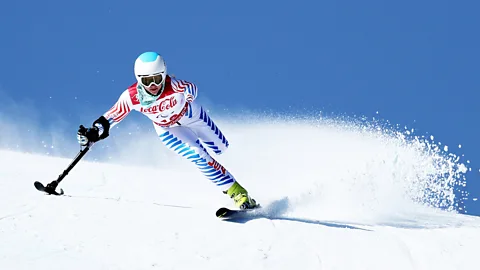'We want to leave a legacy of health': The race to make the Paralympics safer for athletes
 Getty Images
Getty ImagesShoulder injuries, concussions and the "big red flag" of Alpine skiing: what research reveals about the Paralympics' riskiest sports, and how to make them safer.
As a long-distance wheelchair racer competing for the United States, Cheri Blauwet won seven medals at the Paralympic Games. Now an associate professor of physical medicine and rehabilitation at Harvard Medical School, she researches sports injuries among Paralympians – a problem she knows well from her own life as an athlete.
While sport is known to be generally very beneficial for people with disabilities, research has revealed that at the elite level, Paralympic athletes face a higher risk of illness and injury than their Olympic counterparts. At the Rio 2016 Summer Games, 12% of Paralympic athletes reported an injury, compared to 8% of Olympic athletes. At the Beijing Winter Games, a study of Team USA found that Paralympic athletes faced almost double the risk of injury compared to Olympic athletes, and more than double the risk of illness.
Some sports such as football, judo and alpine skiing are particularly injury-prone. But Blauwet and other researchers note that the risk is not only about the sport but also linked to the athletes' type of impairment.
Understanding this complex link better could help prevent injuries and keep athletes safe at the Games, researchers say, as well as offering wider insights into what it means to stay fit and healthy as a person with disability.
 Getty Images
Getty ImagesWhen one body part takes all the load
Over the past decade, research by Blauwet and her colleagues has shed light on the nuanced causes and consequences of injury.
"We found for example that athletes who are wheelchair users, like myself, are at a much higher risk for upper limb injuries, particularly involving the shoulder," compared to athletes who did not use wheelchairs, explains Blauwet.
That high injury risk is due to the fact that these athletes are putting so much load on the shoulder, both in daily life and also in sport, says Blauwet, who is currently at the Paris 2024 Paralympic Games in her role as president of the United States National Paralympic Committee and member of the International Paralympic Committee Medical Committee. "This one part of the body takes all the force, in terms of pushing your wheelchair, getting in and out of the car, getting dressed in the morning, getting in and out of the bed – all of those typical things, but then also going to [compete]," she says.
It doesn't mean sport as such is bad for wheelchair users, however. Shoulder pain from overuse is generally common in wheelchair users, not only in athletes, and amateur sport may in fact help protect the shoulder area by strengthening it.
At the elite level, however, shoulder pain can not only affect an athlete's performance but have consequences far beyond the Games, as Blauwet herself has observed.
"When I see these findings come through in the research I say, yes, absolutely, this demonstrates with the data what my lived experience was," she says. "As someone who's used a wheelchair pretty much my whole life and then also competed as an elite wheelchair racer – long distance, 5000m, 10,000m and up to marathon – I've definitely experienced, both over the course of my athletic career and then after, more day-to-day symptoms regarding my shoulders," she adds.
In the worst case, injuries can have dramatic long-term consequences for a person's independence. "For a wheelchair user, someone who relies on their upper extremity for their life and daily mobility, to develop rotator cuff tears and shoulder arthritis, when they're still in the prime of their life, is very problematic and very prohibitive from a functional standpoint," Blauwet says. "It can impact their life, their family, their career."
To better understand the risk of injury and protect athletes' health, scientists have gathered data from every Paralympic Games since London 2012 for all the roughly 4,500 competitors in summer and 500 in winter. Using a web-based monitoring system, team doctors log athletes' injuries and illnesses before and during the competition.
"We monitor every athlete at the Games," says Phoebe Runciman, a senior lecturer in disability sport at Stellenbosch University in South Africa. She and her team, led by Wayne Derman, a professor of sports and exercise medicine at the university, are running the monitoring system for the Paris 2024 Games, which take place from Aug 28 to Sept 8.
 Getty Images
Getty Images"Until [we started using this system] we'd never really understood what we were looking at, in terms of what kinds of injuries the athletes get, what kind of illnesses they get," Runciman says.
Certain patterns of injury and illness consistently show up at every Games, she says. The higher risk of shoulder injury for wheelchair users is one such consistent finding. Another is that Paralympic athletes are at greater risk of illness than Olympic athletes, partly due to conditions linked to different impairments – a rubbing prosthesis, for example, raises the risk of skin problems.
One complex finding concerns the risk of concussion, which may be especially high for an athlete with visual impairments.
Concussion in the spotlight
Concussion has received growing attention in the sporting world, for example in American football and in rugby, because of its potential long-term impact on brain health. Runciman and other scientists have called for more to be done to correctly diagnose and prevent concussion at the Paralympic Games.
"The problem with concussion is that you have a brain disturbance," Runciman says. "You can have one concussion and be fine, but what happens in the brain over time with multiple concussions, is that those blows over time can lead to severe degenerative neurological conditions [such as Parkinson's]."
Diagnosing concussion in athletes with disabilities can be difficult, she says, because standard tests that check for symptoms such as double vision or loss of balance may not be suitable. A person with visual impairments would, for example, not be able to do the vision test, and a person in a wheelchair would not be able to do the balance test, Runciman says. As a result, concussion is probably under-reported, she warns.
One way to better detect it is to perform a health check on Paralympic athletes before the competition, to establish a baseline against which any potential symptoms after a crash or collision can then be compared.
One example of such a high-concussion-risk sport is five-a-side football, played by blind athletes and athletes with visual impairment, all blindfolded to create the same conditions for everyone.
"You have a group of five-on-five athletes, all blindfolded to completely obscure their vision, and they're all going for the ball at once," says Blauwet. "So certainly collision happens, contact happens, head-to-head contact happens."
Just as shoulder injuries can worsen day-to-day life for wheelchair users, concussion may be especially burdensome for people with visual impairment. In one small study of English blind footballers, the participants mentioned that spatial orientation and sleep were important to function in daily life and were affected by concussions.
In five-a-side football, the players shout to signal where they are on the field and if they are about to tackle to help avoid such risky collisions.
Concussion is also a risk in judo and taekwondo at the Paralympics, and in cycling when athletes crash, Runciman adds.
Safer sport
Research, and action from Paralympic organisers, have already helped make one Paralympic winter sport safer: alpine skiing.
"Alpine skiing was just a big red flag with far too many injuries, quite severe injuries, and it needed attention," says Runciman. "You’ve got people coming down a slope at 100 km/h (62 miles/h) with no vision, or with a spinal cord injury, or with two amputated legs." This puts the athletes at very high risk, she says.
 Getty Images
Getty ImagesA study based on data collected during the Sochi 2014 Games picked up on the sport's especially high injury rate. Going into the PyeongChang 2018 Games, medical teams and organisers devised a number of adjustments, such as changing the time of day for better conditions, which made the slopes safer. "The PyeongChang injury rate drastically dropped in alpine skiing," Runciman says, falling from 44 injuries per 1000 athlete days in Sochi to 23 per 1000 athlete days in PyeongChang. "The small rule changes and the changes in environmental setting allowed the sport to be participated in more safely."
She hopes protecting the health of these elite athletes will ultimately show that sport is safe for people with disabilities: "The body, and the brain, need you to push the barrier for your muscles to grow, for your nerves to develop good pathways. The message is, get your kids active as soon as possible." One of her goals is to help more people with severe disabilities to get fit through sports such as frame running, where athletes are supported by frames.
Blauwet also emphasises that being active is important for people's health across many different types of disabilities. She puts research into practice to manage her own shoulder symptoms, through strengthening exercises and by using well-fitting equipment. Making sure wheelchairs fit the athlete well, and therefore put the least stress possible on the shoulder and upper limb, has also been effective in helping prevent shoulder strain and injury during the Paralympics, she says.
"We know that it's obviously fantastic to engage in sport at the community level, and then once an athlete reaches that elite level, it's all about keeping them healthy," she says.
"What we want is that once athletes retire, they're not broken down. So when they're 40, 50, 60 and beyond, they can look back on their athletic career and say, wow, that was a phenomenal part of my life, and my health benefited from being an athlete. We want to be sure we leave a legacy of health."
--
If you liked this story, sign up for The Essential List newsletter – a handpicked selection of features, videos and can't-miss news, delivered to your inbox twice a week.
